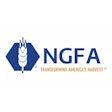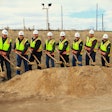When it comes to the feed and grain industry, safety should be at the front of every mind in the mill. From upper management to line workers, workplace safety is a critical component to running a smooth and successful operation.
No matter the safety statistics of your operation, there is always room for improvement. Employees are your company’s biggest asset, and keeping them safe should be the most important goal for any executive or manager in the industry. Creating a culture of safety in the workplace takes time; however, without it, the end result could be catastrophic. 1.Set the tone
1. Set the tone
Building a culture of safety in the workplace begins with upper-management. Behaviors trickle down the chain of command — if executives and managers do not emphasize safety, workers will not take it seriously. Managers must use their influence to promote safety at all times and in all areas of the operation.
Managers are responsible for keeping safety in the minds of employees at all times. Resources and time must be invested into safety in order for employees to take it seriously. Incorporating safety into every meeting, including staff and planning meetings, is imperative to creating a culture of safety in the workplace.
“If you do not bring up safety during meetings, I would seriously question if top management supports safety,” said Wayne Bauer, director of safety and security at Star of the West Milling. “If top management does not support safety, it will be extremely hard to show employees that you care about them.”
Showing employees that you value their well-being is critical to cultivating a strong manager-employee relationship, Bauer explained.
Another important aspect of setting the tone and creating a culture of safety in the workplace is maintaining visibility among workers. When employees believe they will never see a manager, there is a greater risk of sloppy safety techniques, explained Harry Rupe, safety consultant for Roadway Worker Training.
“As a manager, you have to get out of the office and into the workplace,” Rupe said. “This shows employees you are there and lets them know you care.”
Rupe said he believes a boss-worker relationship is successful when you show you are on the employee’s side and you want to keep them safe. 2. Address concerning comments
2. Address concerning comments
Getting out of the office and onto the mill floor with your employees is a great way to connect and show them you care about their well-being. However, experts agree the key to earning employee trust is listening to their safety concerns and immediately addressing the issues.
“Talking to your employees is important because it sheds light on what is really happening on the floor,” said Matt Solymossy, safety manager for Landmark Services Cooperative. “You have to take concerns from employees seriously and immediately address the issues at hand.”
Creating trust between managers and workers directly hinges upon being proactive in addressing safety concerns in a timely manner, Rupe explained.
“If you want employees to respond to what you want, you have to respond to them and address what they want,” Rupe said. “This sends the message that you care and are willing to do what it takes to keep them safe.”
Experts agree that displaying concern for employee well-being reflects that safety is extremely important and should be taken seriously. When top management addresses these issues in a timely manner, this increases the importance of safety, allowing it to become second nature to employees. 3. Provide positive feedback
3. Provide positive feedback
No one likes a “Negative Nelly,” especially when it comes to important issues such as safety. If you are only giving negative feedback to employees, their morale will suffer. If adjustments are needed, handle the situation as a learning experience. Some workers may not realize what they are doing is wrong. If top management is educational and encouraging when addressing safety issues, employees will respond in a positive manner.
At the same time, it is critical to positively reinforce good safety-related behavior among employees, such as wearing Personal Protective Equipment in and around the facility and following proper lockout/tag-out procedures when working with heavy equipment.
“It is important for employee supervisors to provide positive feedback to their employees,” Solymossy said. “A majority of the time, employees only hear negative feedback from their managers. But, if you encourage positive behavior, it really boosts their confidence and morale.”
Upper management is responsible for encouraging positive behavior in the workplace. Creating a positive atmosphere is imperative to crafting a culture of safety in the workplace.
“When it comes to safety, you need to be a coach,” Rupe said. “You have to tell them when they are doing good things and remind them they need to be safe so they can go home to the people they love.” 4. Hold everyone accountable
4. Hold everyone accountable
One of the biggest keys to creating a culture of safety in the workplace is creating accountability among all employees. When it comes to being safe on the job, everyone is equal. It does not matter if you are a manager or seasonal worker — being safe is the name of the game, and everyone is playing it. A system of accountability among all employees will increase positive safety behavior and reduce the pressure on upper-management.
“All positions are equal when it comes to safety in the workplace,” Solymossy said. “Keeping everyone equal not only keeps everyone safe, but also keeps everyone accountable.”
Encouraging all employees to get involved in the safety process gives each worker a sense of ownership. People respond to responsibility.
“Accountability is achieved through setting measureable goals,” Waltz said. “After the goals are set, there must be the expectation that employees will meet those goals and support others in doing the same.” 5. Give the right incentives
5. Give the right incentives
Safety incentives give upper management a way to reward great safety behavior in the workplace. Incentives give employees a goal to reach for and can really boost the morale of the group. Regardless if it is a gift certificate won in a drawing, or a shirt handed to everyone after a “zero-accident” period of time, rewards create pride among employees and keep everyone accountable.
“There is a lot of peer pressure in safety, especially when there is a reward involved,” Bauer said. “Incentives encourage feedback and accountability between workers. They also promote safety discussions among employees. Everyone wants a reward, so everyone wants to stay safe.”
However, for every positive there is a negative. Although there can be great benefits to implementing safety incentive programs within the workplace, there are also some downsides.
“If people are only thinking about safety because they want to get a reward, they are thinking about it for the wrong reason,” Waltz said. “Sometimes in a reward setting, people fail to report accidents or injuries out of fear of taking the reward away from everyone.”
The secret key
The “key” to creating a culture of safety in the workplace is not doing just one thing right — it is the combination of doing many things right. You must make safety important from the top down. Upper management must show employees that safety is not only a requirement, but it is also a strong company value. Managers have to be out in the field listening to worker concerns and immediately taking action to resolve any issues at hand.
Once you show your employees they are valued, you support them, and you want to keep them safe, safety behaviors will become second nature to employees. This is a culture of safety.

















